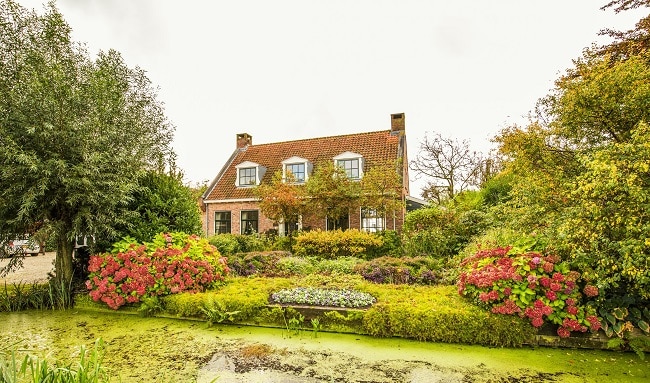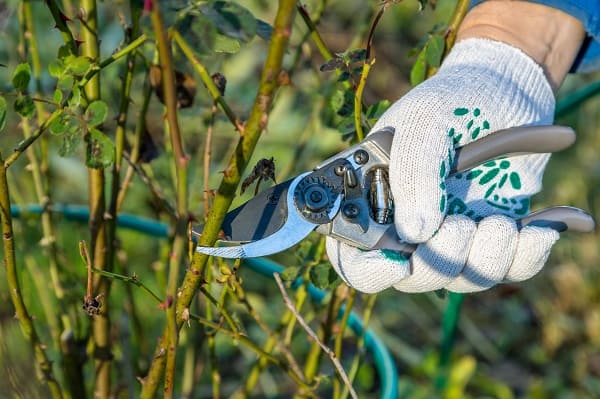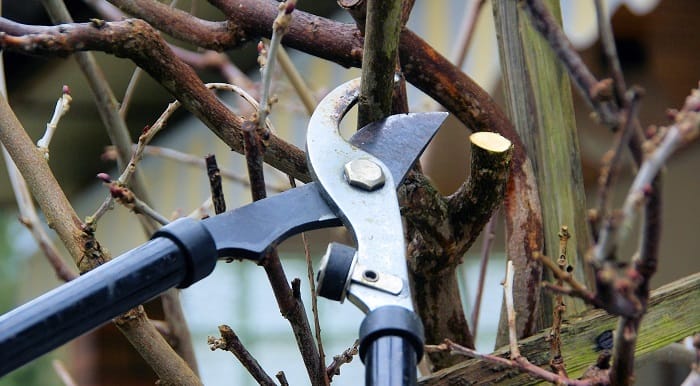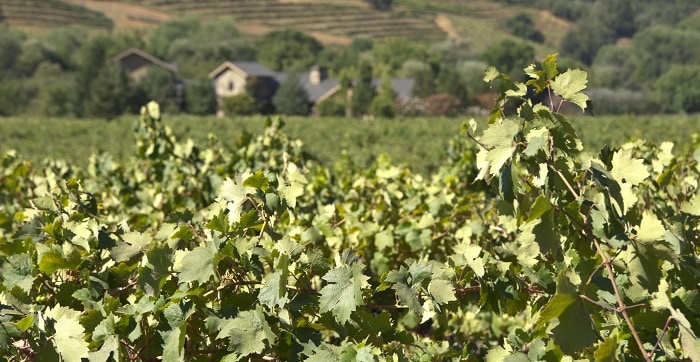
Caring for plants in the right ways is one of the most important things you can do to keep them healthy. For many plants, healthy maintenance includes necessary trimmings, but this may be an intimidating task for anyone who may not know the difference between pruning, lopping, and trimming and how to know what your plants need.
Pruning, lopping, and trimming are methods of cutting the growth of plants to either maintain their health or to keep them looking pristine. The difference between pruning, trimming, and lopping is in the cutting techniques and methods as well as the results achieved through these various types of cuts.
Home gardeners and horticulturists have experimented with different methods of cutting plants to keep them heathy and beautiful. Knowing the difference between pruning, trimming, and lopping and which plants require which method as outlined below will help you to keep your plants happy.
Pruning
Pruning is the practice of selectively removing certain parts of plants to shape them, keep them healthy, prepare them for transplanting, or to increase produce yield. This selective removal of buds, flowers, roots, and branches is motivated by several different factors.
The key to pruning is the selective and targeted removal of diseased, dead, or otherwise unwanted materials from the plant. As opposed to lopping and trimming, pruning involves being able to recognize which parts of the plant are unhealthy.
You might think that plants wouldn’t prune themselves in their natural environments, but wind, rain, and other weather conditions prune plants in ways that might not be accessible in fenced yards or greenhouses. For this reason, gardeners have to help plants along when they are grown outside of their natural habitat.
Some fruit plants need to be pruned to stay healthy and increase yield, while trees require pruning when branches are diseased, dead, or interfere with structures or powerlines. It is possible to simply pinch the tips off of some plants to keep them healthy and looking nice. In other cases, and especially when pruning trees, special tools are required.
What Plants Need Pruning?
There are many different plants that require careful, selective pruning to maintain their health such as many fruit trees and flowers, while many others need pruning to make sure their branches don’t cause problems for buildings, power lines, or those walking below them.
Seasonal Pruning
Pruning can be done year-round, but each season comes with its own methods and purposes, and not all plants should be pruned in each season. With just a bit of knowledge, you can take advantage of each time of year and make sure that your plants are ready for each coming season.
Spring Pruning
Certain plants do well with a springtime pruning, preparing them for the growth season. Some of these plants include the following:
- Spring-flowering, non-fruiting shrubs
- Young fruit trees
- Hedges and topiaries
- Conifers
- Woody perennial herbs
- Diseased and dead growth
Hobby Farms has done a great job explaining each of these categories while also offering a few handy tips for the process.
Summer Pruning
Summer is when the plant world is alive and everything is in full bloom, but great conditions can also lead to plants growing so well it can quickly get out of hand. To keep growth in check for a harmonious and thriving garden in which your plants have the space and light they need to continue growing, pruning to thin out cluttered areas and parts that aren’t doing well will allow the rest of the plants to do better.
The Swansons Nursery of Seattle, WA has a comprehensive article that further explains how to go about summer pruning as well as some things to keep in mind as you go about the process.
Fall Pruning
There is a general rule of thumb that says no pruning in the fall. Pruning promotes new growth, something you don’t want to encourage as the weather gets colder. The plant must prepare to remain dormant through the winter months and pruning should wait until at least late winter. However, as with most things, there are a few exceptions, some of these including the following:
- Dead limbs
- Plants that attract slugs
- Diseased perennials
- Suckers sent out of the base of some plants
Check out this article from HGTV that goes into further detail about these exceptions so that you can go about your pruning with confidence.
Winter Pruning
Although it may come as a surprise that there is pruning to be done in the cold winter months, the lack of leaves on many bushes and deciduous trees makes it an ideal time. It is much easier to see the structures of these plants without the covering of leaves, making it easier to carefully and intentionally trim certain branches for the benefit of their long-term health. In addition, winter pruning help in promoting strong growth come spring.
Winter pruning includes removing diseased or dead limbs as well as creating space for those that are healthy. It is the maintenance of the body of the plant so that it can be its healthiest and most productive self when it blooms. Here is Hobby Farms’ article on winter pruning with some great tips on how to go about pruning different types of plants this season as well as what to watch out for and which plants to leave alone.
Pruning Tips

While pruning isn’t necessarily difficult once you know how to go about it, there are certain techniques that will help you go about the process correctly.
- Understand the type of cut you are making. Different cuts will lead plants to react in different ways, so understanding your goal in pruning will allow you to decide which type of cuts you need to make. While thinning cuts aim to promote more even growth throughout the tree, heading back or shearing cuts aim to promote denser growth at the tips to create a fuller and bushier look.
- Do your cuts correctly. Cuts should be made at a 45-degree angle and be done close to a bud or branch, following the angle of that growth. Alternately, if the buds are across from each other, make a straight cut about ¼” above both of them.
- Properly cut large branches. They should not be pruned directly at the collar right away, but rather several inches out from it, allowing the bark on the trunk to stay in-tact. The process is best done in three steps:
- Make the initial cut on the underside of the branch, several inches away from the branch collar.
- Make a second cut on the topside of the branch a couple inches farther out than the first cut. This should create enough of a weak spot for the branch to snap.
- Make a third cut closer to the collar to leave only a stub. Now that the weight of the branch is much less, the risk of tearing the bark is also greatly reduced.
Swansons Nursery’s Lena Curl put together a wonderful guide she calls Pruning 101 that goes into further detail on how to go about pruning, complete with diagrams depicting how and where to cut for different desired effects.
This video by the Arbor Day Foundation is also a great visual depiction of how to go about pruning a tree.
Lopping
Lopping is similar to pruning except that it does not have to be as careful or selective of a process. Lopping generally only applies to trees that have become too large for the space they occupy.
Some arborists warn against indiscriminate lopping. If you lop too much height or foliage off of a tree, it can temporarily starve the tree of nutrients. Leaves and foliage are the photosynthesis centers of the trees and, as such, they produce most of the chlorophyll that the trees need to stay healthy.
Home or property owners who want to reduce the size of trees on their property can contact a professional tree-cutting service or arborist that will know how to properly lop branches off of a tree so that the tree can both be reduced in size and still remain healthy.
Trimming

Many gardeners will utilize the terms “pruning” and “trimming” interchangeably, but there is a difference between the two. While pruning is conducted to maintain the health of a plant, trimming refers to the practice of cutting back plants that are overgrown, similar to lopping.
While lopping refers to cutting back overgrown trees, and trimming refers to cutting back overgrown shrubs, bushes, and any other plants. As with pruning, trimming often requires specific tools for the job, such as large trimming shears or an automatic trimming saw.
A benefit of trimming shrubs and bushes is that properly trimmed plants make it easier to control pests and insects. Trimming shrubs keeps them looking nice and feeling healthy.
Dealing with shrubs and bushes adds a unique layer of aesthetic value to the job. Shrubs and bushes are often used as decorative features in yard landscaping. Due to their density, especially if they have been properly pruned, they also make great privacy screens and “living fences”
What Plants Need Trimming?
Evergreen shrubs, such as the popular boxwoods, bay laurel, and the many beautiful varieties of Ficus need regular trimming to stay beautiful. Since trimming is done to maintain the size and aesthetic of a plant rather than to remove diseased or dead branches, trimming is fairly simple.
The one thing to remember when going about trimming is that the leaves of plants are their power centers. Trees and shrubs need a good amount of foliage to continue to absorb sunlight and photosynthesize the nutrients in the soil. Avoid trimming too much of the foliage off of trees and shrubs so that they have enough leaves to continue to photosynthesize.
Pruning, Lopping, and Trimming Tools
Having the right tools makes pruning not only easier, but safer as well. Take caution when pruning, especially with trees and other larger plants, and be sure of every cut before you make it. Items like gloves, long sleeves, and safety glasses should always be used during pruning, but there are also other specialized tools including the following:
- Pruning shears, also known as pruners, clippers, or secateurs. These are ideal for smaller pruning jobs such as on shrubs, vines, and flowers. There are three common types of shears that all serve a specific purpose.
- Bypass pruners act like scissors and are best used for stems that are alive and growing. This pair of 8 inch bypass pruners (link to Amazon) would be great for most backyard projects.
- Anvil pruners have a straight blade to split dry branches and stems. This 10 inch pair of anvil pruners (link to Amazon) will cut up to 5/8 inch of deadwood.
- Ratchet pruners split wood like anvil pruners do, but they also have a mechanism that does this in stages, making the job easier on the wrists of those using the shears. These ratchet pruners (link to Amazon) claim to improve your hand’s power by three times its strength and comes with an ergonomic design and slip-proof handle for the most comfort and efficiency.
- Loppers are similar to pruning shears, but have thicker blades and longer handles to tackle larger jobs. This pair of loppers (link to Amazon) claims to cut through 2 inch thick branches and multiplies the force applied to them by three.
- Pruning saws can be manual or automatic and come in various sizes but are generally used for branches 1 ½ – 5 inches in diameter. This pruning saw (link to Amazon) has a curved blade and is ideal for branches 9-10 inches long.
- Hedge shears are for hedges, shrubs, evergreens, or for deadheading perennials, so long as the branches are under approximately 2 inches in diameter. This pair of hedge shears (link to Amazon) is lightweight and even has extendable handles.
- Hedge trimmers come in three basic varieties including the following:
- Gas powered trimmers allow for freedom of movement and are powerful enough to cut through thick branches. While these are effective, they do require you to know how to mix the oil and fuel and are noisy enough to be banned by some town associations. This 2 cycle gas powered hedge trimmer (link to Amazon) has 23 cc’s and only weighs 11 lbs.
- Corded electric hedge trimmers are generally the cheapest variety of trimmers, are easy to use, and are very quiet in comparison to gas trimmers. These are a great option as long as where they are needed is not too far from an outlet. This corded electric hedge trimmer (link to Amazon) is lightweight and can cut through branches up to 5/8 inch thick.
- Cordless hedge trimmers run on lithium-ion batteries, allowing for freedom to roam without the exhaust and noise of a gas trimmer. These are generally in the middle of the price range, although the power of the motor will increase along with a higher price tag. This cordless hedge trimmer (link to Amazon) has a 40 volt battery to cut through branches up to ¾ inch thick.
- Pole pruners come as manual and automatic and are used to reach deadwood. Most reach up to 8 feet and can cut branches up to about 1 ¼ inches in diameter. This pole pruner (link to Amazon) features a 360-degree swivel head for easy access to branches.
Plants that Require Special Pruning
Each pruning, lopping, and trimming job is unique, but certain plants require special maintenance. These are some popular and commonly found plants that require some personalized care.
Roses
Roses are prized for their beauty and scent, and many people also use the flowers and buds for flavoring syrups and teas. Rose bushes require regular maintenance to ensure that they produce blooms and stay healthy. Gloves are necessary to protect from thorns and steel bypass shears will allow you to easily remove branches.
There are different strategies for pruning roses in the spring, when you want to encourage new growth, and in the summer and fall, when your goal is to encourage blooms and keep the plant healthy through the winter.
In the spring, rose bushes require heavy pruning to remove any deadwood and any branches that rub or cross each other, as that can cause damage and disease. This step requires first removing all the leaves from a plant that haven’t fallen off through the winter.
The desired shape is a V-shape that opens up toward the top of the rose bush. After major pruning in the spring, many gardeners trim dead buds in the summer to encourage new blooms and healthy growth through the season.
Additionally, because roses have something of a delicate constitution, sanitize the blades of your pruners before pruning up the next bush. If one is hiding a disease (like Witch’s Broom), you don’t want to spread it to other plants.
Strawberries
Strawberry plants, like most berry bushes, require pruning throughout the summer growth season. Strawberry bushes produce runners that will try to take root and naturally propagate new plant growth.
Runners take nutrients from the main plant, however, and inhibit the production and yield of fruits. Simply cut the runners with shears or pinch them off, being careful not to damage the bush or roots. Strawberry bushes also do well with a light prune at the end of the grow season.
Trees
Pruning trees, depending on the kind of tree you need to prune, might take some heavy-duty tools but is vital to preserving the health of the tree. Trees should be pruned anytime branches are reaching into spaces over or near buildings or powerlines, or when branches are damaged or diseased.
Pruning dead or diseased branches from trees, also called deadwooding, is often preformed for safety to avoid those branches falling off unexpectedly and injuring someone or damaging property below. Often, homeowners will hire companies that are dedicated to tree maintenance to prune their trees because it can require large, expensive equipment and be quite dangerous.
Houseplants
Pruning houseplants is similar to pruning outdoor plants, just generally on a smaller scale. Most houseplants are pruned to remove dead matter, which can include deadheading flowering plants to help them propagate fuller.
Any cuttings made that aren’t dead, damaged, or diseased can be placed into water to be propagated and replanted. The Spruce has a great article explaining exactly how to go about this process.
Vines

Vines often grow with great abundance, so they can require regular pruning especially during spring and summer months to keep them from getting out of hand. Furthermore, especially in indoor settings, vines are best grown along a support both to physically hold them as well as to direct their growth.
Plants Not to Prune
While many plants do great with methodical pruning, there are some plants that don’t take well to it. Various varieties of palms as well as Norfolk Island pines only have one dominant bud without any latent buds, meaning that pruning would just kill the entire plant. Orchids are another species that should not be pruned much. Although dead flowers can be removed at their base stem, no pruning should be done beyond this.
Pruning and the Law
It may come as a surprise, but sometimes the legalities of pruning can get a bit sticky. In general, a tree belongs to whoever owns the land that the tree originates from. However, plants don’t necessarily adhere to the same boundaries that humans put in place, so particularly when dealing with plants encroaching on the property of your neighbors, it may be best to check the laws first. Some occasions in which it may not be legal to prune a tree are as follows:
- The Theft Act of 1968 made it illegal to pick fruit, flowers, or other parts off of trees that are not your own. While this is usually not strictly enforced, it gives owners the right to ask for these parts to be returned.
- Overhanging branches and encroaching roots may sometimes pose a problem. In these cases, it is legal to trim branches to the extent of your own property line as well as digging up and cutting any roots that bore their way into your yard. However, the Theft Act of 1968 can also be enforced in this situation.
- Preservation orders are placed on specific trees as a means of protection, for which a permit from local authorities is required in order to perform any form of cutting or uprooting.
- The 1959 Rights of Light Act protects a different kind of property, that being a property’s sunlight. This act states that if your property has received daylight for the last 20 years, then it is entitled to continue to receive that same light. If a neighbor’s trees grow so large that they begin blocking your light, you are legally entitled to request their pruning.
When to Call a Professional
Much pruning, especially on smaller plants, can be done by homeowners, but there are certain instances in which it is best to call a professional. There are many arborists and tree care companies that will know the laws and have the tools to get the job done properly and easily. Some instances in which a professional service should be called include the following:
- When trees grow within 10 feet of power lines.
- Large jobs that require climbing, ladders or chainsaws.
- When the branches that need pruning pose a safety hazard, such as when they hang over rooftops or sidewalks.
Hiring a Professional Tree Service
Before hiring a professional service, be sure to know what to inquire about to ensure that you are getting the best service for your money as well as a company that will be equipped for the job and knowledgeable about how to go about it. As described in this article on Angie’s List, certain qualifications to check for include the following:
- Credentials and licensing
- Insurance
- Reviews and referrals
- Cost estimate and what is being charged for
- Equipment
- Employee training
- Steps taken to minimize damage to your property
It is important to know that who you hire is in-fact its own company with paid employees instead of one that sub-contracts jobs because this allows for quality assurance. These companies will also be more likely to have allow of their legal bases covered and will likely be educated and trained on how to best go about the pruning and trimming process.
Final Thoughts on Pruning, Lopping, and Trimming Your Plants
Pruning, lopping, and trimming your plants is an important part of the plant care process. With the above knowledge on what to strive for in your process, what needs to be pruned, and how to perform the cuts, the task no longer has to be an intimidating one. There are also many tree-care services available to help anyone keep their plants happy and healthy for years to come. Whichever route you go, understanding our green friends helps us make the best decisions for them.

